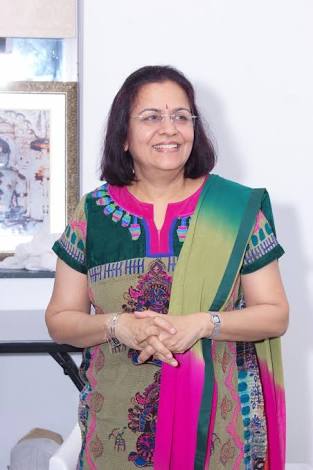(9th Acharya of Jain Swetambar Terapanth sect)
A Mural Painting by Dr. Manju Nahata
Size: 56 feet x 4 feet Base: Cloth mounted on the board Medium: Tempera, Earth colours
IMPORTANT ABHIYANS
(Panel 3)

[ large size ]
A regular evening prayer in Terapanth sect was, initiated by Acharya Tulsi, has been shown: ‘Om jai jai tribhuvan …’. A dark patch in the sky suggests evening time with associated images, namely the sky, the moon, a star, an owl on a tree, and a village girl waiting for her cattle to return home.
In the nether part of the panel a life-span motif is shown through the depiction of the stages of life: childhood, adulthood and old age. The relevance of the motif is in its emphasis that no stage in life should be wasted.
Acharya Tulsi’s first and important pada-yatra was towards Delhi in 1950. So, India Gate, Qutub Minar has been painted just to suggest his destination.
He went to Rashtrapati Bhavan to meet the then President Dr. Rajendra Prasad and talked about the importance of Anuvrat (small vows), which can change the spirit of the era (Badle yug ki dhara anuvraton ke dwara). It was a fruitful meeting.
Next, Acharya Tulsi, extending his field of work, introduces a new campaign: ‘Shad-Abhiyan’,a Six Point Move in life, painted here symbolically in a ‘Shad-Chakra’ in a lotus (symbol of purity) with an inner eye placed in the centre. The campaign in English translation reads as follows: unity of feeling; purity of election; unity of sects; honesty in business; uplift of the Dalit; and temperance for all. The campaign, ensconced in a rectangle, has respective symbols on the left and time reference on the right. I have taken an artist’s freedom to draw an elephant and a ringing bell below the rectangle only to suggest, the huge impact the campaign had during (1949-1961) and after. The flag and the garland on the right side of the lotus are suggestive of the victorious campaign.
Way back in 1946 Adarsh Sahitya Sangha was established in Sardarshahar. In the year 1955 editing of Jain Treatise was started in Maharashtra. Acharya Tulsi is shown in standing posture holding the old book ‘Dasvealiyam suttam’, the first line of which ‘Dhammo mangal mukkittham’ is boldly painted in original Prakrit language. Then there is Muni Nathmal (Acharya Mahapragya as he is known now) holding the newly edited copy of ‘Dasvaikalika Sutra’ with its first line boldly painted in Hindi (dharma hi utkrishta mangal hai). Between them is drawn a saffron circle atop which is the picture of ‘Shrutadevi’ without whose blessings no such wisdom comes. The circle includes a four-faced conch shell as if it were announcing a noble work. The waves in dark- blue suggest the length of the time taken in editing the treatises 1955 onward, though the editing is still being continued under the supervision of Acharya Mahapragya. A light blue diamond shape has ‘Om’ written in its different four scripts.
One will notice the front portion of a house, skirting the panel- Ladnun Seva Kendra estd. in 1857 (meant only for old sadhvis), completed its centenary. There is another centre, Parmarthika Sikshan Sansthan established in 1949. In this section of the panel we find a ‘mumukshu sister’ in namaskara mudra. Her vision goes beyond the panel 3 to meet another ‘mumukshu sister’ (Kala) in panel 4. Above it we can see a verse of a song which says ‘Sanyamamay Jivan Ho’. A five-angled star stands for five senses and the moon for our mind to restrain the senses and the mind from going astray. This verse is 50-year-old but is still popular and relevant.
 Dr. Manju Nahata
Dr. Manju Nahata